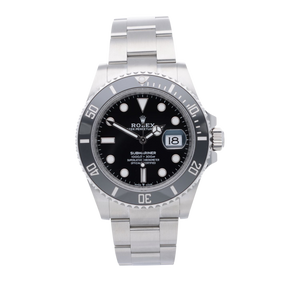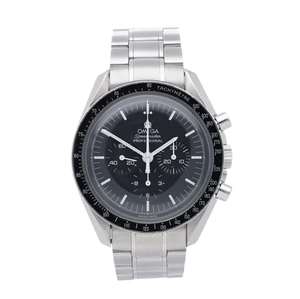Rolex or Omega
A company history spanning over 100 years, a range of coveted luxury watches, and a world-renowned name: Omega and Rolex have all of this in common. These two giants of the watch industry have always been in competition with each other and are often mentioned in the same breath. But which actually produces the better watches, Rolex or Omega? In our comprehensive Rolex vs. Omega comparison, we take a close look at both brands, focusing on their history, the specific advantages and disadvantages of the watch manufacturers, and individual comparable watch models from Rolex and Omega.
Which watch is the better investment: Rolex or Omega?
Those who buy a Rolex or Omega watch often do so with the intention of making a sensible investment. After all, luxury watches are considered a popular investment, and not just for die-hard collectors and watch enthusiasts. When purchasing a timepiece as an investment, the choice of model should primarily be based on its value and its prospects for value retention. Logically, after all, the investment is only successful if the investment can be resold with the highest possible profit.
Both Omega and Rolex watches are said to retain their value satisfactorily. These are products from renowned watch brands whose value, with proper care, will remain at the upper end even for decades. However, upon closer inspection, Rolex has the edge in terms of value retention. There are only a few brands whose products are as excellent investments. Rolex watches often change hands for three or even four times their list price. While Omega watches can certainly fetch substantial profits, the high demand among affluent buyers is limited to a comparatively small selection of models. It is primarily the iconic Omega watches that offer a good investment opportunity. In summary, one could say: Omega watches are good investments, and Rolex timepieces are even excellent.
The history and significance of Rolex and Omega in the watch industry
Omega and Rolex have undoubtedly left their mark on the watch world and helped shape it into what it is today. These are two brands whose influence on the watch industry cannot be denied, so we'll take a brief look at the companies' history.
Rolex was founded in 1905 by Hans Wilsdorf and quickly gained a reputation. Rolex watches were notable for their outstanding quality, and the brand quickly became a household name thanks to the innovative patents it registered. From the very beginning, inventiveness and innovation have been the driving force behind the company, which holds an incredible 400 patents to date. For example, the first screw-lock crown for waterproof timepieces originated at Rolex, and Rolex also significantly advanced modern watchmaking with the automatic winding mechanism.
The Omega brand, now part of the Swatch Group, has also provided the industry with plenty of innovations since its founding in 1848. Omega is among the first mass-produced watches with a co-axial escapement. And what other brand can claim that one of its watches accompanied Buzz Aldrin to the moon?
Today, many consumers perceive Rolex as a more well-known and popular brand than Omega. But that wasn't always the case! In the 1960s, Omega was the "big player" in the market and tended to enjoy greater prestige than Rolex. It's no wonder, then, that the two brands are fiercely competing for the top spot in the watch industry.
Luxury watches in comparison: Rolex and Omega in detail
When comparing Omega vs. Rolex, it's important to focus on the manufacturers' luxury watch ranges. Before we discuss individual models from different categories later in this article, let's first take a look at the product range as a whole.
Rolex watches are rightly known for their unsurpassed quality. Every wristwatch that leaves production and goes on sale meets the highest standards of quality and craftsmanship, with extremely low tolerance for anomalies. The Swiss brand's product portfolio is comparatively small. Here, Rolex focuses on presenting an exquisite selection of first-class products—quality over quantity, one could say. In addition, some of the timepieces can be customized to a high degree. For example, you can choose from a wide range of available options for the bezel, dial, and bracelet. Despite the rather limited range, there is something for every taste.
Omega watches, which are on average slightly larger than those of the competing brand, also cover a wide range of categories – from diving watches to dress watches to pilot's watches. The brand pursues a sporty, classic design and, much like Rolex, focuses on optimizing proven models.
While the two major watch brands prefer to produce high-performance, high-end sports watches and share similarities in their brand focus, their brand perceptions differ quite significantly. For watch enthusiasts, for example, it seems perfectly possible to have a relaxed opinion about Omega and to evaluate the brand's watches without emotion. When it comes to Rolex, however, there are only huge fans or staunch critics. When considering Rolex vs. Omega, it can be concluded that Rolex as a brand appears to be significantly more polarizing.
The advantages and disadvantages of Rolex and Omega
When comparing Rolex vs Omega, the question naturally arises as to the advantages that distinguish each watch brand.
Advantages of Rolex
Robustness and durability
Thanks to the high-quality materials and precise, meticulous craftsmanship, a Rolex watch is extremely stable and durable. Depending on the model, various "extras" are also available, such as water resistance, resistance to magnetic fields, or scratch-resistant Cerachrom elements, which make the products even more robust. It's no coincidence that Rolex watches enjoy a reputation for being able to cope with long service intervals and always function reliably.
precision
The manufacturer produces calibers that are hard to beat in terms of precision. When you wear a Rolex watch on your wrist, you can definitely rely on its accuracy—a quality that is of great importance in the watch world.
Preservation of value
As already explained in detail, Rolex is one of the companies whose products retain their value particularly well. These high-quality items from the luxury segment are therefore highly sought-after investments and, in many cases, represent worthwhile investments.
Benefits of Omega
Innovative design
Browsing through the Omega product range, one cannot help but notice that it is characterized by numerous models with innovative designs. In many respects, the brand doesn't necessarily go with the flow, consistently creating astonishingly outstanding watches that clearly fall into the category of "innovative novelties."
Wide product range
And the range is also impressive. It consists of a multitude of exquisite pieces from the renowned manufacturer, catering to a wide variety of tastes. If you're looking for a luxury wristwatch and want a large, diverse selection, Omega is the right place for you.
Progressiveness
If one wants to present the most complete picture of the Omega brand, one topic cannot be ignored: innovation. The progressiveness that characterizes the manufacturer's image is not just an illusion; it reflects absolute reality. Omega repeatedly releases models that clearly stand out from the crowd, which is also reflected in the numerous patents the company holds.
Omega and Rolex models in comparison
Next, we'll look at some models from both brands that fall into the same category and compare them.
Rolex Submariner vs Omega Seamaster
In the diving watch segment, both Rolex and Omega boast true icons. The Rolex Submariner , launched in 1954, remains one of the most popular diving watches in the luxury segment today – just like the Omega Seamaster . Both products are available in various colors, with customers opting most frequently for the classic stainless steel version. They also share quick-adjustable bracelets, a ceramic bezel, and a top-of-the-line movement from their respective watchmakers.
In the Submariner vs. Seamaster diving watch duel, the similarities predominate, but there are still small differences. For example, the Seamaster is equipped with a helium escape valve and co-axial escapement, which the Submariner lacks. The topic of price is also interesting, as there's a huge gap between the two diving watches: On average, the Seamaster is significantly cheaper than the Submariner.
Rolex Daytona vs Omega Speedmaster
In the chronograph category, our Omega vs. Rolex comparison compares the Rolex Daytona with the Omega Speedmaster . Both feature three totalizers and a tachymeter scale, were released between 1957 and 1963, and were designed for racing drivers.
The biggest difference between the Daytona and the Speedmaster is the image and reputation of each watch. While a Daytona is primarily considered a luxury item, the Speedmaster is viewed more as an extremely functional "utility watch." This is reflected in the price, which is considerably lower for the Speedmaster.
Rolex Datejust vs Omega Constellation
They are true highlights of the successful brands' product ranges: the Rolex Datejust and the Omega Constellation collection. These popular product lines include elegant timepieces for men and women, each available in a wide range of elegant colors and featuring a date display.
Datejust and Constellation watches differ primarily in small details, such as the Jubilee bracelet, which is exclusive to Rolex, or the decorative "griffes," which are optional on Omega models. The costs of these watches vary considerably depending on the design and material, but on average, Constellation models are somewhat more affordable.
Rolex GMT-Master II vs. Omega Seamaster Planet Ocean
Finally, in our Omega vs. Rolex comparison, the Omega Seamaster Planet Ocean Master Chronometer meets the legendary Rolex GMT-Master II . These dual-time-zone timepieces feature a date display and are sometimes available in strikingly colored versions. Another similarity: the hands and indices on each watch are coated with luminous material, ensuring excellent readability even in the dark.
The difference between these two high-end timepieces is obvious: While the Rolex GMT-Master II is only water-resistant to a maximum of 100 m, the Omega Seamaster Planet Ocean, a diver's watch with a GMT function, boasts water resistance to 600 m. And in this round, the price difference again favors Omega. Both products are highly functional and real eye-catchers, but the Seamaster Planet Ocean is listed at a lower price.
Conclusion - A question of style and personality
Most watch enthusiasts would probably agree: Both Rolex and Omega timepieces are testaments to the highest watchmaking craftsmanship and pieces of jewelry that enrich any collection. Given the individual advantages of each brand and the iconic models found in both ranges, the question of "Omega or Rolex" is ultimately a matter of personal taste.













